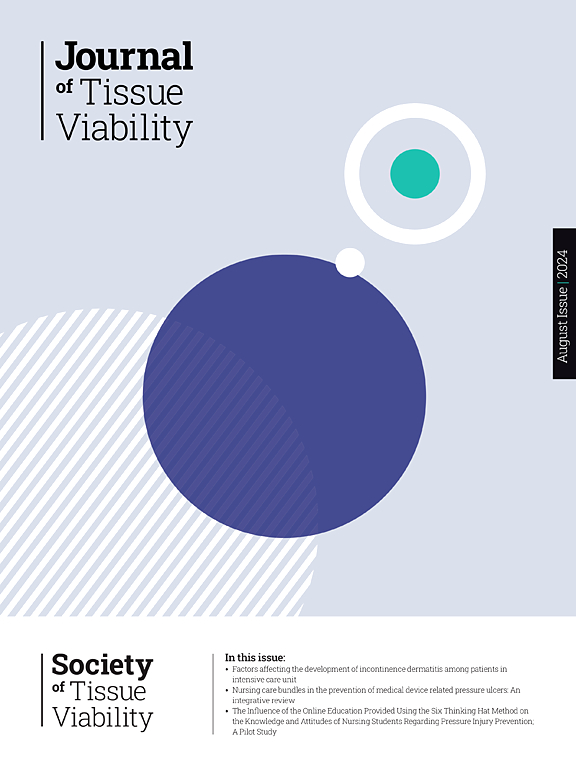Enhancing sickle cell leg ulcer healing with combined photodynamic and photobiomodulation therapies: A pilot experience
IF 2.4
3区 医学
Q2 DERMATOLOGY
引用次数: 0
Abstract
Aim
This study aimed to evaluate the safety and efficacy of combined photodynamic therapy (PDT) and photobiomodulation (PBM) in treating sickle cell leg ulcers (SCLUs), with a focus on pain reduction and enhanced healing.
Materials and methods
In this prospective, open-label, uncontrolled pilot study, ten SCD patients with 17 chronic leg ulcers received PDT and PBM treatments. Ulcer severity, pain levels, and microbiome changes were monitored, and clinical data were analyzed using appropriate statistical methods.
Results
Among the treated ulcers, 64.7 % (11 out of 17) showed significant healing, with 9 ulcers achieving complete closure. The average reduction in ulcer size was significant, with a median healing time of 123 days. Pain levels decreased significantly in 82.3 % of treated ulcers (p < 0.001), and a 75.4 % reduction in bacterial load was observed, alongside increased microbiome diversity (p < 0.05). Elevated levels of IL-6 and PSGL-1 were associated with non-healing ulcers, indicating their potential as prognostic biomarkers.
Conclusion
The combined PDT and PBM therapy proved to be effective and safe for SCLUs, offering significant improvements in healing and pain reduction. These findings suggest that integrating PDT and PBM into standard care protocols could enhance the management of SCLUs.
结合光动力和光生物调节疗法增强镰状细胞腿溃疡愈合:试点经验
目的本研究旨在评估联合光动力疗法(PDT)和光生物调节(PBM)治疗镰状细胞性腿部溃疡(SCLUs)的安全性和有效性,重点是减轻疼痛和促进愈合。材料和方法在这项前瞻性、开放标签、无对照的先导研究中,10例伴有17例慢性腿部溃疡的SCD患者接受了PDT和PBM治疗。监测溃疡严重程度、疼痛水平和微生物组变化,并使用适当的统计方法分析临床数据。结果接受治疗的溃疡中,64.7%(11 / 17)溃疡明显愈合,9例溃疡完全愈合。溃疡大小的平均减少是显著的,平均愈合时间为123天。接受治疗的溃疡患者中有82.3%的疼痛水平显著降低(p <;0.001),观察到细菌负荷减少75.4%,同时微生物组多样性增加(p <;0.05)。IL-6和PSGL-1水平升高与未愈合溃疡相关,表明它们作为预后生物标志物的潜力。结论PDT联合PBM治疗SCLUs是一种安全有效的治疗方法,可显著改善患者的愈合和减轻疼痛。这些发现表明,将PDT和PBM纳入标准护理方案可以加强对sclu的管理。
本文章由计算机程序翻译,如有差异,请以英文原文为准。
求助全文
约1分钟内获得全文
求助全文
来源期刊

Journal of tissue viability
DERMATOLOGY-NURSING
CiteScore
3.80
自引率
16.00%
发文量
110
审稿时长
>12 weeks
期刊介绍:
The Journal of Tissue Viability is the official publication of the Tissue Viability Society and is a quarterly journal concerned with all aspects of the occurrence and treatment of wounds, ulcers and pressure sores including patient care, pain, nutrition, wound healing, research, prevention, mobility, social problems and management.
The Journal particularly encourages papers covering skin and skin wounds but will consider articles that discuss injury in any tissue. Articles that stress the multi-professional nature of tissue viability are especially welcome. We seek to encourage new authors as well as well-established contributors to the field - one aim of the journal is to enable all participants in tissue viability to share information with colleagues.
 求助内容:
求助内容: 应助结果提醒方式:
应助结果提醒方式:


